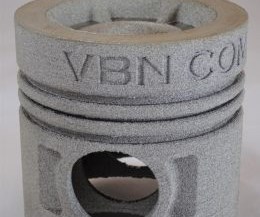Postprocessing Guidelines Expected To Increase Adoption of Additive Manufacturing
Financed by Swedish agency Vinnova, VBN Components’ MacAM project will be executed in partnership with Swedish metals research institute Swerim, Sandvik Coromant and 3M.
Share










.png;maxWidth=45)
DMG MORI - Cincinnati
Featured Content
View More

The market for additively manufactured (AM) components with new metals is increasing each year, according to Swedish metals firm VBN Components, which has announce a postprocessing optimization project called MacAM. Financed by Swedish agency Vinnova, the project will be executed in partnership with Swedish metals research institute Swerim, Sandvik Coromant and 3M. The project is intended to advance techniques for machining AM parts in order to encourage more companies to adopt additive manufacturing.
According to Swerim researcher David Franklin, extremely hard and wear-resistant materials can be produced with AM technology, but it has been difficult for industrial players to adopt the new technology due to lack of experience and understanding of the machining processes required to postprocess these super-hard materials.
The AM process minimizes material use and allows for the creation of advanced structures with, for instance, cooling channels and reduced component weight. However, the surfaces of a 3D printed component need to be machined in order to achieve the required tolerances and smoothness. Samples of VBN’s carbide-rich materials with raw surfaces will be analyzed and machined in a well-controlled environment as part of the MacAM project. From these results, guidelines with recommendations will be created.
“Today, there is a knowledge gap considering grinding and postprocessing of AM components. We are looking forward to this project, which will give new recommendations for tools and knowledge about postprocessing, which is most important for industrial adoption of AM,” says Ulrik Beste, CTO of VBN Components.
Related Content
-
Digital Transparency in Machining Key to Multi-Site Additive Manufacturing
Cumberland Additive’s CNC programmer in Pennsylvania spends most of his time writing programs for machine tools in Texas.
-
Chuck Jaws Achieve 77% Weight Reduction Through 3D Printing
Alpha Precision Group (APG) has developed an innovative workholding design for faster spindle speeds through sinter-based additive manufacturing.
-
Digitalization and Done-In-One Reign Supreme at BIEMH 2024
European manufacturers may have a different balance of markets than their U.S. counterparts, but the practical challenges they must overcome are often similar — as are the solutions.











.png;maxWidth=150)





















.jpg;maxWidth=300;quality=90)

